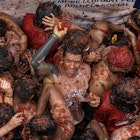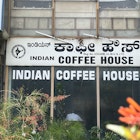There's a vast number of eateries in France. Most have defined roles, though some definitions are becoming a bit blurred. Here's a quick guide:
Auberge
'Auberge' by Ludo29880. Creative Commons Attribution-ShareAlike
An auberge (inn), which may also appear as an auberge de campagne or auberge du terroir (country inn), is usually attached to a rural B&B or small hotel and serves traditional country fare. A ferme-auberge (literally 'farm-inn') is usually a working farm that serves diners traditional regional dishes made from ingredients produced locally. The food is usually served table d'hôte (literally 'host's table'), meaning in set courses with little or no choice.
Bar
'la fourmi' by superbez. Creative Commons Attribution
A bar or bar américain (cocktail bar) is an establishment dedicated to elbow-bending and rarely serves food. A bar à vins is a 'wine bar', which often serves full meals at lunch and dinner. A bar à huîtres is an 'oyster bar'.
Bistro
'P8070034' by philip_sheldrake. Creative Commons Attribution-ShareAlike
A bistro (also spelled bistrot) is not clearly defined in France nowadays. It can be simply a pub or bar with snacks and light meals or a fully fledged restaurant.
Brasserie
'brasserie' by zoetnet. Creative Commons Attribution
Unlike the vast majority of restaurants in France, brasseries – which can look very much like cafés – serve full meals, drinks and coffee from morning till 11pm or even later. The dishes served almost always include choucroute (sauerkraut) and sausages because the brasserie, which actually means 'brewery' in French, originated in Alsace.
Buffet
A buffet (or buvette) is a kiosk, usually found at train stations and airports, selling drinks, filled baguettes and snacks.
Café
'Café des 2 Moulins' by LWY. Creative Commons Attribution
The main focus of a café is, of course, café (coffee) and only basic food is available at most. Common options include a baguette filled with Camembert or pâté and cornichons (gherkins), a croque-monsieur (grilled ham and toasted cheese sandwich) or a croque-madame (a toasted cheese sandwich topped with a fried egg).
Cafétéria
Many cities in France have cafétérias (self-service restaurants), including Flunch, that offer a decent selection of dishes you can see before ordering – a factor that can make life easier if you're travelling with kids.
Crêperie
'Paris 2009' by Edsel L. Creative Commons Attribution
Crêperies (sometimes known as galetteries) specialise in crêpes and galettes. The latter are made with buckwheat flour, whereas crêpes are made with wheat flour.
Relais Routier
'restaurant au Top du Roulier (TOULON-sur-ALLIER,FR03)' by jean-louis zimmermann. Creative Commons Attribution
A relais routier is a transport café or truckstop, usually found on the outskirts of towns and along major roads, which caters to truck drivers and can provide a quick, hearty break from cross-country driving.
Restaurant
'Rue de Choisy, Paris, 2010' by Thomas Claveirole. Creative Commons Attribution-ShareAlike
Restaurants come in many guises and price ranges. Generally restaurants specialise in a particular variety of food (eg regional, traditional, North African). There are lots of restaurants where you can get an excellent French meal for under €30. Chain restaurants (eg Hippopotamus and Léon de Bruxelles) are a definite step up from fast-food places and usually offer good-value (though formulaic) menus.
Almost all restaurants close for at least one and a half days (ie a full day and either one lunch or one dinner) each week - this schedule will be posted on the front door. Chain restaurants are usually open throughout the day, seven days a week. Restaurants almost always have a carte (menu) posted outside so you can decide before going in whether the selection and prices are to your liking. Most offer at least one fixed-price, multicourse meal known as a menu, menu à prix fixe or menu du jour (daily menu). A 'set menu' (not to be confused with a 'carte menu') almost always costs much less than ordering à la carte.
When you order a menu, you usually get to choose an entrée, such as salad, pâté or soup; a main dish (several meat, poultry or fish dishes, including the plat du jour 'daily special', are generally on offer); and a final course (usually cheese or dessert). In some places, you may also be able to order a formule, which usually has fewer choices but allows you to pick two of three courses – a starter and a main course or a main course and a dessert.
Boissons (drinks), including wine, cost extra unless the menu says boisson comprise (drink included), in which case you may get a beer or a glass of mineral water. If the menu has vin compris (wine included), you'll probably be served a 25cL pichet (jug) of wine. The waiter will always ask if you would like coffee to end the meal, but this will almost always cost extra.
Salon de Thé
'Untitled' by sunshinecity. Creative Commons Attribution
A salon de thé (tearoom) is a fashionable and somewhat pricey establishment that usually offers quiches, salads, cakes, tarts, pies and pastries in addition to black and herbal teas.
More guides to eateries in other countries here.
Originally published Oct 2010. Updated Nov 2012.




















